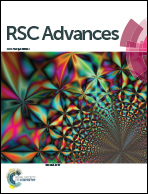The performance and associated mechanisms of carbon transformation (PHAs, polyhydroxyalkanoates) and nitrogen removal for landfill leachate treatment in a sequencing batch biofilm reactor (SBBR)
Abstract
A modified sequencing batch biofilm reactor (SBBR, adding a pre-anoxic phase before the aeration phase) was used to treat landfill leachate. The overall SBBR operation period was divided into a load-increasing period I (69 days) and a steady operation period II (41 days). In period I, the influent total nitrogen (TN) and chemical oxygen demand (COD) concentrations increased from approximately 60 and 400 mg L−1 to 1000 and 6500 mg L−1, respectively, and these were kept for period II. In period II, the COD and TN removal rates were 83–88% and 95–98%, with effluent COD and TN concentrations of less than 500–600 and 10–20 mg L−1, respectively. The end of pre-anoxic phase PHA (polyhydroxyalkanoate) content increased from 0.11 Cmol (start of period I) to 0.22 Cmol (end of period II). The contributions from simultaneous nitrification and denitrification (SND) and endogenous denitrification to the TN removal rate were approximately 60% and 40%, respectively. The mechanisms of carbon transformation and nitrogen removal were: (1) the synthesis of PHAs in the pre-anoxic phase; (2) short-range nitrification; (3) simultaneous nitrification and denitrification (SND); and (4) endogenous denitrification. Microbial diversity analysis revealed that Proteobacteria and Bacteroidetes accounted for 89.66% of the total bacteria. Ammonia-oxidizing bacteria (AOB, Nitrosomonas) and denitrifying bacteria with the ability to transform organic matter into PHAs (Paracoccus and Thauera) are the dominant bacterial communities.



 Please wait while we load your content...
Please wait while we load your content...